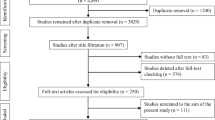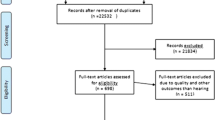Abstract
In all epidemiological studies the validity of self-reported questionnaire data is an important issue as the exposure assessment based on such data is a major source of bias in the risk estimation. A validation study was conducted based on a case–control study including 94 acoustic neuroma cases and 191 matched controls from the German Interphone Study to investigate the level of agreement between self-reported occupational noise exposure and a job-exposure-matrix (JEM) on noise exposure derived from a lifetime occupation calendar. The JEM was generated based on measurement data collected in the literature for various occupations. Level of agreement was investigated by using sensitivity, specificity, kappa coefficient and the Youden-Index. The receiver operating characteristics curve yielded an optimal cut point of 80 decibel(Acoustic) (dB(A)) to dichotomize noise exposure, displaying a moderate agreement between self-reported exposure and the JEM-based exposure (kappa of 0.53) that was slightly higher for cases than controls (kappas of 0.62 and 0.48). The agreement was only slightly lower if the longest held job or the last held job were used instead of the loudest job of the lifetime job history. The cut point of 80 dB(A) corresponds with regulations for workers safety with a recommendation to wear noise protection. The good levels of agreement between self-reported high occupational noise exposure compared with JEM-data, together with no substantial differences between cases and controls, suggest that self-reported data on occupational noise exposure is a valid exposure metric. Noise exposure appears to be appropriate if only exposure information on the last or the longest held job is available.


Similar content being viewed by others
Notes
BGIA and SUVA are government authority like institutions which are in their countries responsible for occupational safety and health. It is also their task to supervise and control their proper application in the workplaces.
Measurements of both agencies followed the rules given by national or European authorities. The BGIA followed the rules of DIN 45 645, Part 2 (L Aeq-method), SUVA measurements followed the following rules: DIN EN ISO 3746: 1995 (sound power level), DIN EN ISO 11200–11204 (emission of sound intensity levels at the workplace), ISO 3744, ISO 4871, ISO 6081, and ISO 1999 as well as special EU-directives, like 79/113/EWG, and 85/405/EWG. Measurements have been performed either by the BGIA or SUVA or by certified agencies according to EN45001.
As the measurements of the BGIA was much too detailed for our purposes we mainly used the SUVA data. The SUVA condensed their measurements for an occupation like road builder into one dB(A) value whereas the BGIA divided this occupation into subgroups like guard rail builder, asphalt layer and others involved in street construction for which the information in our occupational data was not detailed enough.
References
Rothman KJ. Modern epidemiology. Toronto: Little, Brown and Company; 2008. p. 102–12.
Adegoke OJ, Blair A, Ou SX, Sanderson M, Addy CL, Dosemeci M, et al. Agreement of job-exposure matrix (JEM) assessed exposure and self-reported exposure among adult leukemia patients and controls in Shanghai. Am J Ind Med. 2004;45:281–8. doi:10.1002/ajim.10351.
Brigham J, Lessov-Schlaggar CN, Javitz HS, McElroy M, Krasnow R, Swan GE. Reliability of adult retrospective recall of lifetime tobacco use. Nicotine Tob Res. 2008;10:287–99. doi:10.1080/14622200701825718.
Schuz J, Spector LG, Ross JA. Bias in studies of parental self-reported occupational exposure and childhood cancer. Am J Epidemiol. 2003;158:710–6. doi:10.1093/aje/kwg192.
Cardis E, Richardson L, Deltour I, Armstrong B, Feychting M, Johansen C, et al. The Interphone study: design, epidemiological methods, and description of the study population. Eur J Epidemiol. 2007;22:647–64. doi:10.1007/s10654-007-9152-z.
Samkange-Zeeb F, Berg G, Blettner M. Validation of self-reported cellular phone use. J Expo Anal Environ Epidemiol. 2004;14:245–8. doi:10.1038/sj.jea.7500321.
Parslow RC, Hepworth SJ, McKinney PA. Recall of past use of mobile phone handsets. Radiat Prot Dosimetry. 2003;106:233–40.
Vrijheid M, Deltour I, Krewski D, Sanchez M, Cardis E. The effects of recall errors and of selection bias in epidemiologic studies of mobile phone use and cancer risk. J Expo Sci Environ Epidemiol. 2006;16:371–84. doi:10.1038/sj.jes.7500509.
Vrijheid M, Armstrong BK, Bedard D, Brown J, Deltour I, Iavarone I, et al. Recall bias in the assessment of exposure to mobile phones. J Expo Sci Environ Epidemiol; 2008.
Hepworth SJ, Bolton A, Parslow RC, van Tongeren M, Muir KR, McKinney PA. Assigning exposure to pesticides and solvents from self-reports collected by a computer assisted personal interview and expert assessment of job codes: the UK Adult Brain Tumour Study. Occup Environ Med. 2006;63:267–72. doi:10.1136/oem.2005.021022.
Miller MH, Doyle TJ, Geier SR. Acoustic neurinoma in a population of noise exposed workers. Laryngoscope. 1981;91:363–71.
Preston-Martin S, Thomas DC, Wright WE, Henderson BE. Noise trauma in the aetiology of acoustic neuromas in men in Los Angeles County, 1978–1985. Br J Cancer. 1989;59:783–6.
Edwards CG, Schwartzbaum JA, Nise G, Forssen UM, Ahlbom A, Lonn S, et al. Occupational noise exposure and risk of acoustic neuroma. Am J Epidemiol. 2007;166:1252–8. doi:10.1093/aje/kwm217.
Schlehofer B, Schlaefer K, Blettner M, Berg G, Bohler E, Hettinger I, et al. Environmental risk factors for sporadic acoustic neuroma (Interphone study Group, Germany). Eur J Cancer. 2007;43:1741–7. doi:10.1016/j.ejca.2007.05.008.
Daniel E. Noise and hearing loss: a review. J Sch Health. 2007;77:225–31. doi:10.1111/j.1746-1561.2007.00197.x.
Noise and Hearing Loss. In: NIH Consensus Statement 1990, 8. NIH Consensus Development Program—Consensus Development Conference Reports; 1990, 1–24.
European Council. Directive 2003/10/EC of the European parliament and of the council of 6 Feb 2003 on the minimum health and safety requirements regarding the exposure of workers to the risks arising from physical agents; 2008.
Knipfer C, Funke HW. BIA-Report 2/97 Lärmbelastung an Baustellenarbeitsplätzen Part V. St. Augustin, Germany, Hauptverband der gewerblichen Berufsgenossenschaften (HVGB); 1997.
SUVA/Akustik Lärmtabellen 86201.D/F/I—86495.D/F/I. 2002-2004. 2004. Lucerne, Switzerland, Swiss Accident Insurance Fund.
Akobeng AK. Understanding diagnostic tests 3: Receiver operating characteristic curves. Acta Paediatr. 2007;96:644–7. doi:10.1111/j.1651-2227.2006.00178.x.
Ruopp MD, Perkins NJ, Whitcomb BW, Schisterman EF. Youden Index and optimal cut-point estimated from observations affected by a lower limit of detection. Biom J. 2008;50:419–30. doi:10.1002/bimj.200710415.
Kirkwood B. Sterne JA. Wiley-Blackwell: Essential Medical Statistics; 2003.
Landis JR, Koch GG. An application of hierarchical kappa-type statistics in the assessment of majority agreement among multiple observers. Biometrics. 1977;33:363–74. doi:10.2307/2529786.
Tielemans E, Heederik D, Burdorf A, Vermeulen R, Veulemans H, Kromhout H, et al. Assessment of occupational exposures in a general population: comparison of different methods. Occup Environ Med. 1999;56(3):145–51. doi:10.1136/oem.56.3.145.
Mannetje A, Kromhout H. The use of occupation and industry classifications in general population studies. Int J Epidemiol. 2003;32(3):419–28. doi:10.1093/ije/dyg080.
Acknowledgments
The authors like to thank Drs. Maria Blettner, Gabriele Berg-Beckhoff and Jürgen Wahrendorf for providing the data of the German Interphone study and their helpful comments during the conduct of this work. Furthermore we like to thank all our colleagues from the German Interphone team and all the clinicians for their support during the Interphone study. The original Interphone study received major funding from the European Union, Brussels, Belgium (European Fifth Framework Program, “Quality of Life and Management of living Resources” [contract QLK4-CT-19999-01563)], the German Federal Office for Radiation Protection, Willy-Brandt-Straße 5, 38226 Salzgitter, Germany (Deutsches Mobilfunkforschungsprogramm of the German Federal Ministry for the Environment, Nuclear Safety, and Nature Protection); the Ministry for the Environment and Traffic of the state of Baden-Württemberg, Kernerplatz 9, 70182 Stuttgart, Germany; the Ministry for the Environment of the state of North Rhine-Westphalia, Schwannstraße 3, 40476 Düsseldorf, Germany; University of Mainz (MAIFOR Programme), Saarstraße 21, 55099 Mainz, Germany; and the International Union against Cancer (UICC), 62 route de Frontenex, 1207 Geneva, Switzerland. The UICC received funds for this purpose from the Mobile Manufacturers’ Forum and GSM Association. Provision of funds to the Interphone study investigators via the UICC was governed by agreements that guaranteed Interphone’s complete scientific independence. These agreements are publicly available at http://www.iarc.fr/ENG/Units/RCAd.html [07-01-05]. This methodological work was done on the core positions of the involved researchers and therefore the authors thank the German Cancer Research Center and the Danish Cancer Society for their support.
Author information
Authors and Affiliations
Corresponding author
Rights and permissions
About this article
Cite this article
Schlaefer, K., Schlehofer, B. & Schüz, J. Validity of self-reported occupational noise exposure. Eur J Epidemiol 24, 469–475 (2009). https://doi.org/10.1007/s10654-009-9357-4
Received:
Accepted:
Published:
Issue Date:
DOI: https://doi.org/10.1007/s10654-009-9357-4




